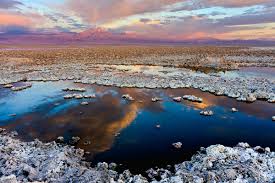Written by: Amanda Campbell, Courtney Nichols, Julianne Sweeney
Many of our modern handheld devices such as cell phones and laptop computers are powered by lithium batteries. Since they are easily recharged, lithium batteries are useful in the growing electric and hybrid vehicle market as well as for storing energy from solar panels. Most of the lithium we use comes from concentrated brines (salt water) and chances are high that it comes from a single source – the Salar de Atacama. This basin in the Andes Mountains has average lithium concentrations of 1,400 mg/L, ~14 times higher than Clayton Valley, Nevada, where the only U.S.-based lithium extraction operation exists. Scientists have found that lithium-rich brines only form in places that meet certain criteria: arid climate, a closed basin with a salt crust (salar) or lake, igneous or geothermal activity, tectonically driven subsidence, a lithium source, and time to concentrate the brine. These conditions allow lithium levels to rise several orders of magnitude higher than the amount of lithium in precipitation or rivers in the area. Yet, much remains to be learned about the mechanisms behind lithium brine formation.
Dr. David Boutt, from the University of Massachusetts at Amherst, is at the forefront of research on lithium brines. On September 20, 2018 he delivered the SU Earth Science Department’s Nelson seminar as the Geological Society of America (GSA) Birdsall-Dreiss Distinguished Lecturer. Dr. Boutt studies the conditions that make the Salar de Atacama the single largest source of lithium. As a hydrologist, he is especially interested in how much groundwater from outside the basin contributes to the lithium brine and where that water is coming from. In his talk, he discussed the lithium sources and how much of it is transported into the basin through groundwater. Although precipitation over the salar is low, it is much greater over the surrounding mountains and this water can carry the necessary amount of lithium to the salar, where it is concentrated by the very high evaporation rate. The naturally-occurring high concentration of lithium in this basin decreases the amount of time required by mining companies during the extraction and concentrating process, making it a valuable lithium source.
Despite increasing demand, current lithium resources are expected to meet future demand for many years, allowing the global population to continue transitioning towards renewable energy sources and a lower carbon footprint.
